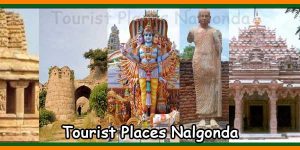Nalgonda has a history that takes us back to the olden times before the reign of the Brahmani dynasty. Nalgonda was formerly called Nilagiri which was later changed to Nallagonda during the Brahmani supremacy. Nalgonda etymologically has a Telugu meaning, Nalla meaning black and Konda meaning Hill.
Many ruling dynasties have made Nalgonda their center of power. Even though its political history was said to be found during the commencement of the Maurya kingdom, its subsistence in the Paleolithic age has been ascertained. The proof of the existence of Nalgonda during this age was established during the excavation done which found tools and weapons distinctive of the Yeleshwaram and Chota Yelupu period.
It was during the rule of the Satavahanas in 230 BC that Nalgonda flourished as a center of significance. The trade with the Romans started during this time and thus Nalgonda became an important place for trading. In 227 AD, the place descended under the control of the Sakas and Scythians. Buddhism also surfaced and multiplied in this region at the same time.
Then the Vishnukundins established their dominance over Nalgonda in the 5th Century AD. They ruled the region without any confronts till the first 10 years of the 7th Century AD. The reign of the Rashtrakutas also gained importance in this place till 973 AD when they were defeated and the rule of Nalgonda was taken over by the Chalukyas of Kalyani.
The Kakatiyas gained ascendancy in the medieval period. But during the Prataprudra’s rule, Nalgonda was once again seized from the clutches of the Kakatiyas by the Muslims and was given away to Muslim rulers. During the control of Muhammad-Bin-Tughluq, his Musunuri chief Kapayanayaka conferred a part of Nalgonda to Ala-Ud-Din Hasan Bahman Shah. Finally, when Ahmad Shah I came in power, it was then that the Bahmani kingdom took possession of Nalgonda. Even though Jalal Khan announced publicly that Nalgonda was independent and tried to emphasize his power over Nalgonda, the place continued to stay under the rule of the Bahamani kings.
Under the Bahamani rule, Sultan Quli became the Tarafdar of Telangana. The regions of Nalgonda were then occupied by the sons of Sultan Quli. Nalgonda completely came under the rule of the Qutub Shahi dynasty by 1657.
After the decline of the Qutub Shahi dynasty, the Mughals and finally the Asaf Jahi dynasties ruled Nalgonda for two hundred and twenty-five years.
The majority of people in Nalgonda speak Telugu. Some other popular languages are Lamani (also called Lambadi), Urdu, Tamil, Yerukala, Hindi, Marathi, Banjara, Malayalam, Kannada, Are, Punjabi, Gujrati, Oriya, and Nepali. The main religions followed in Nalgonda are Hinduism, Islam, and Christianity
.
Where to stay:
Nalgonda has some good stay amenities like Swagat Lodge, the prices (Rs 300-Rs 400), Sri Vijaydurga Hotel, Hotel Balaji Grand (Rs 800-Rs 1400), Kunda Satyanarayana Kala Dhamam and Amrutha Residency (Rs 700-Rs 1800).
How to reach:
Nalgonda has road and rail transport from all main Telangana cities.
Nearest Railway Station:
Nalgonda is a major railway station in the Secunderabad to Guntur way. It comes under the Guntur section of the South Central Railway.
List of Tourist Attractions in Nalgonda:
- Lakshmi Narasimha Swamy Temple Yadagirigutta
- Sai Baba Temple – Dindi
- Sri Ugra Narasimha Swamy temple mandra (located near Uthatoor Road, Kakkireni)
- Sree Venugopala Swamy Temple, located in Burugadda
- Andol Maisamma Temple, located at NH-9,near Malkapur
- Lord Shiva Temples – Nagulapahad
- Hanuman Temple Nalgonda, Telangana Near Surkanti Gudem
- Undrugonda Laxminarasimhaswamy Temple (is known as “devathala konda)
- Varijala Venugopala Swami Devalayam ( located on top of the hill (pedda gutta) 1KM from earth level at
- Goplayapalli village, Narketpalli Mandal.)
- Dharveshipuram Renuka Yellamma Temple is Dharveshipuram
- Sri Veeranarayana Temple located in Kolanupaka
- Chhaya Someshwara Temple Kolanupaka
- Pachchala Ramalingeswara Swamy Temple
- Ramalayam Temple
- Ayyappa Swamy Temple (Sabarimala Ayyappan Temple at Pochampally,)
- Old Lakhsmi Narasimha Swamy Temple
- Parvathi Ammavari Temple (Cheruvugattu hill shrine in Narketpally)
- Sri Parvathi Jadala Ramalingeshwara Swamy Temple – Cheruvugattu
- Sai Baba Temple Nakerakal
- Swayambhu Shambhu Lingeswar Temple
- Lord Sri Venkateshwara Temple
- Shambhu Lingeshwara Temple
- Sai Baba Temple Latif Saheb Hill
- Shiva temple – Pillalamarri
- Shree Shree Renukarcharya Swamy – Archaeological Museum
- Sri Meenakshi Agasteswara Swamy Temple in Wadepalli village of Miryalguda Mandal.
- Vemulakonda Gutta – Laxmi Narasimha Swamy Temple Mastyagiri
- Markandeya Temple Pochampally village
- Shiridi Sai Baba Temple 100 Feet Sthoopam Sakhapur
- Saibaba Temple Chintapally
- Sri Laxmi Narsimha Swamy Mattapalli
- Sri Lakshmi Narasimha Swamy Temple – Vadapalle
- Kolanupaka Jain Temple
- Sunkishala SV Temple Nalgonda
- Nagulapahad Nalgonda
- Nandikonda Village Nalgonda
- Sri Anjaneya swami Gudi is located in Chennaram, Near Mallepally
- Bramha Mandir is located on Latif Saheb Hill.
- Swayambhu Shambhu Lingeswar Temple in Mellacheruvu
Shambhu Lingeshwara Temple at t Panagal near Nalgonda town - Lord Sri Venkateshwara Temple is located in Panagal
- Pachchala Ramalingeswara Swamy Temple is an ancient temple at Panagal
- Chaya Someswara Swamy Temple is located in Panagal village
- Lotus Temple, Yadagirigutta
- Kunda Satyanarayana Kala Dhamam – Surendrapuri


Recent Comments